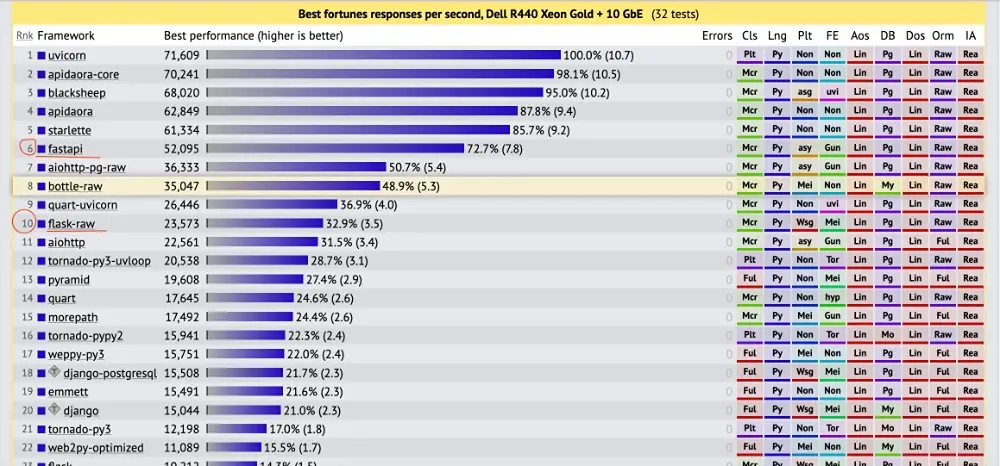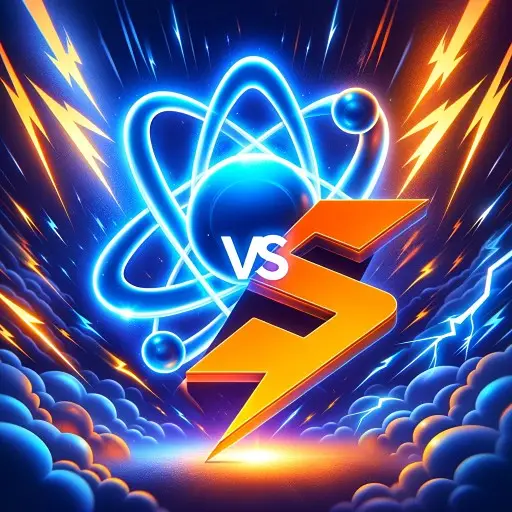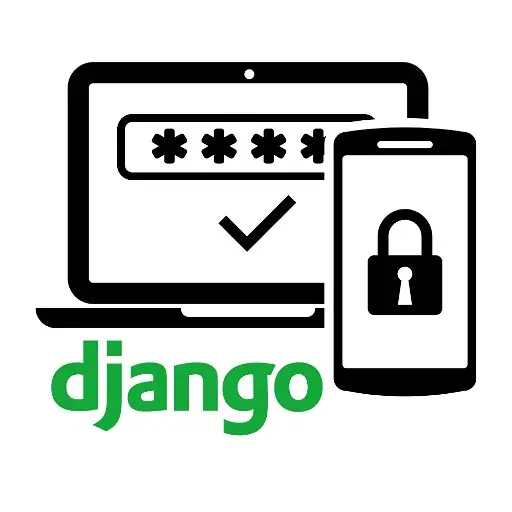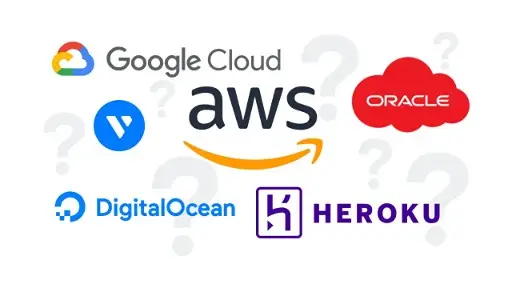FastAPI vs Flask: A Comprehensive Comparison for Python Developers
As a seasoned Python developer, I've navigated the evolving landscape of web frameworks, each with its unique flair and capabilities. Among these, FastAPI and Flask have stood out, not only for their popularity but also for their distinct approaches to web development in Python. In this article, I'll share my experiences and insights, diving deep into both FastAPI and Flask, to help you determine which framework might be the best fit for your next project.
FastAPI: A Modern Entrant
FastAPI is a relatively new entrant in the Python web framework arena, but it has quickly gained traction due to its impressive performance and ease of use for building APIs. It's designed to be fast, intuitive, and easy to learn, which resonated with my penchant for efficient and scalable solutions. Its key features include:
- Asynchronous Support: FastAPI is built on Starlette for the web parts and Pydantic for the data parts, enabling it to handle asynchronous requests efficiently.
- Automatic API Documentation: With FastAPI, generating documentation for your APIs is a breeze, thanks to its automatic, interactive API documentation using Swagger UI and ReDoc.
- Data Validation and Serialization : Its seamless integration with Pydantic means you get automatic request validation and serialization, which is a boon for data-intensive applications.
Flask: The Lightweight and Flexible Veteran
On the other side of the spectrum is Flask, a framework that I've turned to for numerous projects, particularly when simplicity and flexibility were top priorities. Flask's minimalist and extensible nature makes it a go-to choice for many Python developers who prefer a 'less is more' approach.
It's characterized by:
Simplicity and Flexibility: Flask's micro-framework design allows you to add only the components you need, making it ideal for both small-scale applications and complex projects with custom requirements.
Extensive Libraries and Extensions: Flask's mature ecosystem provides a wealth of extensions for tasks ranging from user authentication to database integration.
The Importance of Framework Selection
Choosing between FastAPI and Flask isn't just a technical decision; it's a strategic one. It involves considering factors like project requirements, team expertise, and long-term maintainability. In my journey, each framework has had its moment to shine, depending on the context and goals of the project at hand.
Through this article, I'll share the nuances, strengths, and limitations of both frameworks, drawn from real-world application and development experience. Whether you're building a rapid prototype, a scalable API, or a full-fledged web application, understanding the capabilities of FastAPI and Flask is key to a successful Python project.
What is FastAPI?
FastAPI emerged as a game-changer in my toolset, particularly for projects where performance and rapid development were key. It's a modern, fast (high-performance), web framework for building APIs with Python 3.6+ based on standard Python type hints. The framework has been designed to offer an intuitive, easy-to-use interface while ensuring high performance.
Key Features and Advantages
Asynchronous Support: One of FastAPI's standout features is its native support for asynchronous request handling. This means it can handle many concurrent API requests, making it incredibly efficient, especially for I/O bound and high-latency operations. In my projects, this translated to a noticeable improvement in response times and scalability.
Automatic API Documentation: FastAPI automatically generates interactive API documentation (including Swagger UI and ReDoc). This feature was a significant time-saver in my projects, making it easy to test and document APIs without the extra workload of writing separate documentation.
Data Validation and Serialization: Utilizing Pydantic for data validation, FastAPI ensures that incoming data is valid and correctly serialized. This built-in validation mechanism streamlines the process of error handling and data preprocessing.
Dependency Injection System: FastAPI includes a simple yet powerful dependency injection system. It's particularly useful for shared logic (like database connections), authentication, and authorization.
Performance: FastAPI is built on Starlette for the web parts, which makes it one of the fastest Python frameworks available. For projects where performance is a critical factor, FastAPI stands out significantly.
Ideal Use Cases for FastAPI
Building High-Performance APIs: For applications where performance is a critical requirement, FastAPI shines with its asynchronous capabilities and speed.
Rapid Development: Thanks to its automatic documentation and code generation features, FastAPI is ideal for projects that require rapid development without sacrificing quality or performance.
Applications Requiring Complex Data Processing: The integration with Pydantic makes FastAPI an excellent choice for applications that involve complex data processing and validation.
Microservices Architecture: Its ease of use, scalability, and asynchronous support make FastAPI a suitable choice for microservices-based applications.
FastAPI quickly became one of my preferred frameworks for API development, especially in scenarios that demanded speed, reliability, and ease of maintenance. Its robust feature set caters to a wide range of applications, making it a versatile tool in the modern developer's toolkit. If you're venturing into a project that aligns with these strengths, FastAPI could be an excellent choice. Let's move on to explore Flask in the next section.
What is Flask?
In my journey as a developer, Flask has often been my go-to framework for its simplicity and elegance. Flask is a micro web framework for Python, known for its minimalistic approach and ease of use. It provides the basic tools needed to get a web application up and running, giving developers the freedom to choose how they want to implement things.
Key Features and Strengths
Simplicity and Minimalism: Flask's minimalist design is both its hallmark and strength. It comes with the essentials to build a web app but doesn't enforce any dependencies or project layout. This simplicity makes Flask incredibly approachable and easy to start with, especially for beginners or for small-scale projects.
Flexibility and Extensibility: Despite being a micro-framework, Flask is highly extensible. You can add as many or as few extras as you like, depending on your project's needs. This includes extensions for object-relational mappers, form validation, upload handling, various open authentication technologies, and more.
Unopinionated Framework: Flask doesn't impose any 'best way' to do things. This unopinionated nature allows you the flexibility to structure your application the way you see fit and choose the tools that best suit your needs.
Built-In Development Server and Debugger: Flask comes with a built-in development server and a lightweight debugger, making the development process smoother and more efficient.
Jinja2 Templating: Flask uses the Jinja2 templating engine, which means you can create dynamic web pages with ease.
Common Scenarios for Using Flask
Small to Medium Web Applications: Flask is ideal for small to medium-sized web applications due to its simplicity and minimalistic approach.
Rapid Prototyping: When speed is of the essence, Flask’s ability to get an application running quickly makes it perfect for rapid prototyping.
Educational Purposes and Simple Projects: Its straightforward nature makes Flask an excellent tool for educational purposes, helping new developers understand the basics of web development without overwhelming them.
Customizable Applications: For applications that require a high level of customization and don't fit into the conventional patterns of larger frameworks, Flask provides the necessary freedom.
Flask has been a reliable companion in many of my projects, particularly when I needed a quick, straightforward solution without the overhead of more complex frameworks. Its 'bring your own tools' approach gives you the freedom to build your application exactly how you want it. In the next sections, we'll compare the performance aspects and developer experience of both Flask and FastAPI .
Performance Comparison
In the world of Python web frameworks, the performance debate often circles around FastAPI and Flask. FastAPI's asynchronous capabilities position it as a high-performance framework, especially when it comes to handling concurrent requests. Flask's synchronous nature offers simplicity and ease of development, though it may not match the raw performance of its asynchronous counterparts.
FastAPI's Asynchronous Capabilities
FastAPI's design leverages modern Python's asynchronous features, which allow it to handle a large number of simultaneous connections. This is particularly useful for I/O-bound operations, such as accessing databases and APIs, where FastAPI outperforms traditional synchronous frameworks.
Benchmark data, such as the one from your provided images, showcase FastAPI's impressive request handling capabilities. On a MacBook Pro with Python 3.7, FastAPI consistently outperforms Flask in terms of requests per second. However, it's important to note that Python has seen performance improvements in its later versions, particularly enhancing asynchronous operations, which could further widen this gap.
Flask's Synchronous Nature
Flask operates synchronously, which means each request needs to complete before the next one is processed. This can limit Flask's scalability under high load compared to asynchronous frameworks. Nevertheless, Flask's performance can be more than adequate for a wide range of applications, particularly where the load is moderate and response time requirements are not as stringent.
When considering the Techempower benchmarks, which show FastAPI ranking high among various frameworks, it's crucial to remember that these benchmarks are conducted under ideal conditions that may not reflect real-world scenarios.
In the web we can find a lots of benchmarks. For example:

Image source
Real-World Performance Considerations
In practice, the performance of a web application is influenced by many factors beyond the web framework's raw speed. This includes:
- Application Code: The efficiency of the application code itself can have a significant impact on performance.
- Database Access: How the application accesses and handles data can be a bottleneck.
- Caching Mechanisms: Implementing caching strategies using tools like Redis, Nginx, or CDN services like Cloudflare can dramatically improve response times and reduce server load.
- Hosting Environment: The server's hardware and network capabilities also play a role in the application's overall performance.
Given these variables, it's advisable for developers to conduct their own performance tests in an environment that mirrors their production setup as closely as possible. This will provide a more accurate picture of how either framework would perform under specific conditions.
In summary, while FastAPI shows superior performance in benchmarks due to its asynchronous nature, Flask remains a strong contender for many web applications where ease of development and simplicity are prioritized. The choice between the two should take into account the specific use case, expected traffic, and the development team's familiarity with asynchronous programming. Remember, leveraging additional performance optimization techniques, such as caching, is essential regardless of the chosen framework.
Ease of Learning and Developer Experience
FastAPI
Learning Curve: FastAPI is designed to be easy to use, with a focus on speed and quick development. However, the learning curve can be steeper for those unfamiliar with asynchronous programming in Python. Developers need to understand Python type hints and the async/await syntax, which are central to FastAPI's operation.
Developer Tools: FastAPI offers excellent developer tools out of the box, including automatic interactive API documentation with Swagger UI and ReDoc, which I found extremely helpful when building and testing APIs.
Community and Resources: While FastAPI's community is growing rapidly, it's relatively new compared to Flask. This means there are fewer resources, tutorials, and third-party plugins available. However, the quality of the official documentation is superb, and the community is active and supportive.
Flask
Learning Curve: Flask's simplicity makes it very accessible, especially to beginners or those coming from other programming languages. The lack of enforced project structure or dependencies means you can start small and learn as you go, which was a major advantage in my early days of Python development.
Developer Tools: Flask’s ecosystem is mature, with a wide array of extensions for adding functionality as needed. While it doesn't provide API documentation tools by default, third-party tools such as Flask-RESTPlus can be used.
Community and Resources: Flask benefits from a large, well-established community. There's a wealth of resources, from extensive documentation, tutorials, courses, to an abundance of open-source projects for reference. Community support is one of Flask’s strongest points.
Developer Experience Comparison
When comparing the developer experience between FastAPI and Flask, it's clear that both frameworks offer distinct advantages. FastAPI is modern and fast, with more built-in tools for today's web API development needs, while Flask's minimalist and flexible nature allows for a gentle introduction to web development with the ability to scale up as needed.
Both frameworks cater to different developer needs and preferences. FastAPI is ideal for developers looking to leverage modern Python features and create high-performance APIs, whereas Flask is better suited for those who prefer simplicity and a gradual learning curve. As a developer, the choice often comes down to the specific requirements of your project and your comfort level with Python's asynchronous features.
Ecosystem and Flexibility
Flask Ecosystem
Flask's ecosystem is one of its most significant strengths. As a micro-framework, it's designed to be extended with libraries that suit your project's needs.
Libraries and Extensions: Flask's ecosystem is mature, with extensions that cover virtually every aspect of web development. From Flask-SQLAlchemy for database interactions to Flask-WTF for forms and Flask-Login for user authentication, these extensions are well-maintained and documented.
Flexibility: Flask allows you to structure your application as you see fit. This flexibility means that you can start with a single file and expand to a complex application structure as needed.
Scalability: With the right architectural decisions and proper use of extensions, Flask can scale efficiently. However, as it is synchronous, you may need to run multiple instances to handle high loads or use tools like gevent for asynchronous capabilities.
FastAPI Ecosystem
FastAPI's ecosystem, while newer, is rapidly growing. It's built on Starlette for the web parts and Pydantic for the data parts, which provides a solid foundation for asynchronous applications.
Libraries and Extensions: FastAPI doesn't have as many dedicated extensions as Flask because it doesn't need them. Many features are already built-in, and thanks to its Starlette foundation, it's compatible with most ASGI-based libraries.
Flexibility: FastAPI is more opinionated than Flask but still offers flexibility in how you write your application. Its dependency injection system is a powerful feature that provides a lot of flexibility in structuring your code.
Scalability: FastAPI inherently supports asynchronous request handling, making it well-suited for applications that need to scale to handle large numbers of concurrent users or heavy I/O operations.
Both Flask and FastAPI offer rich ecosystems that cater to modern web development needs, though they approach extensibility and scalability differently. Flask's long-standing presence has fostered a wealth of resources and extensions, while FastAPI's modern approach offers built-in features and a growing number of tools, making it an increasingly attractive option for new projects.
Choosing between Flask and FastAPI will depend on several factors, including your team's familiarity with asynchronous programming, the performance requirements of your project, and your preference for a more traditional versus modern approach to Python web development.
Code Examples: Flask vs. FastAPI
Flask Example:
To create a basic API endpoint in Flask that lists books, you might write the following:
- from flask import Flask, jsonify
-
- app = Flask(__name__)
-
- # Sample data
- books = [
- {"id": 1, "title": "Flask for Beginners"},
- {"id": 2, "title": "Advanced Flask"},
- ]
-
- @app.route('/books', methods=['GET'])
- def list_books():
- return jsonify(books)
-
- if __name__ == "__main__":
- app.run(debug=True)
-
FastAPI Example:
Achieving the same functionality in FastAPI would look like this:
- from fastapi import FastAPI
- from pydantic import BaseModel
- from typing import List
-
- app = FastAPI()
-
- # Define data model
- class Book(BaseModel):
- id: int
- title: str
-
- # Sample data
- books = [
- {"id": 1, "title": "FastAPI for Beginners"},
- {"id": 2, "title": "Advanced FastAPI"},
- ]
-
- @app.get('/books', response_model=List[Book])
- def list_books():
- return books
-
Analysis of Differences and Similarities:
Defining Routes: Both frameworks use decorators to define routes. Flask uses @app.route, while FastAPI uses @app.get, @app.post, etc., to denote the HTTP method.
Data Representation: FastAPI uses Pydantic models to define data structures and automatically handle data validation and serialization. Flask, in its simplest form, uses dictionaries and lists to represent data and relies on jsonify to convert the data to JSON format.
Type Annotations: FastAPI leverages Python's type hints to validate and serialize request and response data. Flask does not use type hints in the same way and often requires additional libraries for similar validation.
Development Server: Both examples include a development server that can be started with app.run() in Flask and simply running the FastAPI application with a command like uvicorn main:app --reload.
These examples illustrate the succinctness and expressiveness of both Flask and FastAPI . Flask's minimalism is evident, as is FastAPI's more structured approach with data models and automatic documentation.
Security and Maintenance
FastAPI:
Built-in Security Features: FastAPI provides several security features out of the box, including support for OAuth2 with Password (and hashing), plus JWT tokens. FastAPI also leverages Starlette for some security features, such as CORS middleware, HTTPS redirect, and trust in proxy headers which are essential for secure deployments.
Ease of Maintenance: The structure imposed by FastAPI, with its dependency injection system and automatic documentation, facilitates maintenance. Type hints and built-in validation help catch errors early, and automatic documentation keeps API documentation up to date, reducing technical debt.
Security Best Practices: Always use HTTPS to protect data in transit. FastAPI's automatic validation ensures that incoming data adheres to the expected schema, reducing the risk of injection attacks. Dependency injection also encourages a cleaner codebase, making it easier to update and secure dependencies.
Flask:
Built-in Security Features: Flask provides basic security features to protect against common threats such as SQL injection, cross-site scripting (XSS), and cross-site request forgery (CSRF) — the latter through the Flask-WTF extension. Flask also offers secure cookie settings.
Ease of Maintenance: Flask’s simplicity can be a double-edged sword; the freedom it offers means maintenance largely depends on the initial codebase's quality. However, the plethora of extensions available allows for a highly modular and maintainable code structure if used wisely.
Security Best Practices: For Flask, using extensions like Flask-Talisman can help manage security headers, while Flask-SeaSurf can help prevent CSRF attacks. Always escape user input to prevent XSS, and never store plain-text passwords — use Flask-Bcrypt for password hashing.
General Security Tips for Both Frameworks:
- Keep Dependencies Updated: Regularly update all framework and library dependencies to patch any known vulnerabilities.
- User Authentication: Implement robust user authentication and authorization. Use tokens or sessions securely and ensure sensitive operations are protected.
- Input Sanitization: Validate and sanitize user input to prevent injection attacks. Use serializers in FastAPI and form validation in Flask.
- Logging and Monitoring: Maintain a proper logging mechanism to monitor suspicious activities. This can help in early detection of security breaches.
- Security Audits: Conduct periodic security audits and consider penetration testing to uncover any potential security issues.
Real-World Application Examples
Real-world application examples offer valuable insights into how frameworks perform outside of controlled tests and benchmarks. Both FastAPI and Flask have been employed successfully in various projects, from startups to large enterprises. Let’s explore some examples.
FastAPI
Since its release, FastAPI has been gaining popularity for its performance and ease of use in building APIs. It's been adopted by a number of companies for production-grade systems.
Uber : One of the more notable examples is Uber, which uses FastAPI for its internal project templates. The high performance, ease of development, and automatic documentation have been cited as reasons for its adoption.
Netflix : Netflix has employed FastAPI for several Python-based internal tools. Its ability to handle asynchronous requests efficiently has been a key factor in its usage.
Flask
Flask's simplicity and flexibility have made it a favorite for a wide range of applications, from small-scale projects to large, complex web services.
Pinterest : Pinterest uses Flask for its API layer, leveraging its lightweight and modular nature to serve billions of requests per day.
LinkedIn : LinkedIn has utilized Flask for various internal tools and applications, taking advantage of its ease of deployment and extensibility.
Insights into Framework Usage
Both frameworks showcase their strengths in these real-world applications. FastAPI’s modern features like asynchronous support make it suitable for high-performance applications, especially where concurrency is a factor. Flask's simplicity and flexibility shine in scenarios where a microservices architecture or a clean, straightforward implementation is preferred.
For startups and smaller companies, Flask’s minimalistic approach allows for rapid development without the overhead of more heavyweight frameworks. Meanwhile, FastAPI is quickly becoming the go-to choice for modern applications that require fast, asynchronous processing.
It's important to note that the choice of a web framework often depends on the specific needs of the project, the existing infrastructure, and the expertise of the development team. While Flask has been a longstanding choice for many, FastAPI’s growing adoption reflects a shift towards asynchronous frameworks in the Python community.
Future Outlook and Trends
In the dynamic landscape of web development, both FastAPI and Flask are poised to adapt and grow. While FastAPI may lead the way in performance, particularly for asynchronous tasks, Flask's simplicity and flexibility will continue to endear it to a broad spectrum of developers. It will be interesting to see how these frameworks evolve and how the community's innovative contributions will shape their trajectories.
FastAPI's Trajectory
The current trend shows a rising adoption of FastAPI, thanks to its performance and ease of use for building modern web APIs. The framework's asynchronous support aligns well with the industry's move towards non-blocking I/O operations, making it particularly suitable for real-time web applications.
Predictions : Given its growing popularity and feature set, FastAPI is likely to see increased adoption in both startups and enterprise environments. Its community is expected to grow, which will lead to a richer ecosystem of tutorials, resources, and third-party tools. Moreover, as Python continues to develop its asynchronous capabilities, FastAPI will benefit and potentially become a standard for async web applications in Python.
Flask's Endurance
Flask has been a mainstay in the Python web framework landscape for many years. Its simplicity and extensibility have fostered a large, dedicated community. Despite the emergence of asynchronous frameworks, Flask's synchronous model and ease of use continue to make it a preferred choice for many developers.
Predictions : Flask is expected to maintain a strong position, particularly among those who prioritize a lightweight and straightforward framework. While it may not boast the same performance metrics as FastAPI in asynchronous operations, its extensive ecosystem and the ability to scale through various means ensure its relevance. Furthermore, the ongoing development of Flask by the Pallets project promises continued support and enhancement, which will help maintain its robust community.
General Trends and Industry Movements
The web development industry is embracing more performant and scalable web solutions. The shift towards microservices architectures and containerization with tools like Docker and Kubernetes is influencing the frameworks being chosen. Both FastAPI and Flask are well-suited to these trends, each in their own right.
Frameworks that support rapid development, with a focus on performance and security, are positioned to be frontrunners in the future. As the community around Python continues to grow, both FastAPI and Flask will evolve, potentially incorporating more features and integrations to suit the developers' and market's needs.
Conclusion
In this comparative journey, we've unpacked the distinct worlds of FastAPI and Flask. FastAPI, with its modern approach to asynchronous programming, offers high performance and is well-suited for applications that require real-time features and handle heavy I/O operations. Its automatic API documentation and validation are boons for rapid development and reduced boilerplate code.
Flask, the venerable micro-framework, champions simplicity and flexibility. Its unopinionated design and extensive selection of extensions make it an enduring choice for developers who appreciate a minimalist yet powerful framework that can grow with their application's needs.
Summary of Key Comparisons:
Performance: FastAPI generally outperforms Flask in terms of speed, particularly with asynchronous operations.
Ease of Learning: Flask's minimalistic approach can be easier for beginners, while FastAPI's reliance on modern Python features has a steeper learning curve but also offers more out-of-the-box functionality.
Community and Ecosystem: Flask boasts a mature ecosystem with a plethora of resources, while FastAPI's community, though newer, is active and rapidly growing.
Flexibility and Scalability: Flask offers extensibility through its extensions, whereas FastAPI provides more built-in features and is inherently scalable due to its asynchronous nature.
Choosing Between FastAPI and Flask
Your choice between FastAPI and Flask will hinge on the specific requirements of your project and your team's expertise. Consider FastAPI if your project demands cutting-edge performance and you're comfortable with the latest Python features. Opt for Flask if you need a proven, flexible framework that allows you to start simple and scale up as needed.
No matter which framework you choose, both are backed by vibrant communities and a wealth of documentation, ensuring support as you develop your web applications. Remember, the best framework is the one that aligns with your goals, enhances your productivity, and meets the demands of your project.

Svelte vs React: A Detailed Comparison for Modern Web Development

Explore our in-depth comparison of Svelte and React. Understand their speed, scalability, pros, and cons to make an informed decision for your web development needs.

Understanding Django Authentication: A Comprehensive Guide

Django, a high-level Python web framework, simplifies the process of building secure and maintainable websites.

Top Hosting Platforms for Python Django in 2024: Unleashing Performance & Reliability

Explore the best hosting solutions for Python Django in 2024. Discover top-performing platforms offering exceptional speed, reliability, and scalability for your Django applications